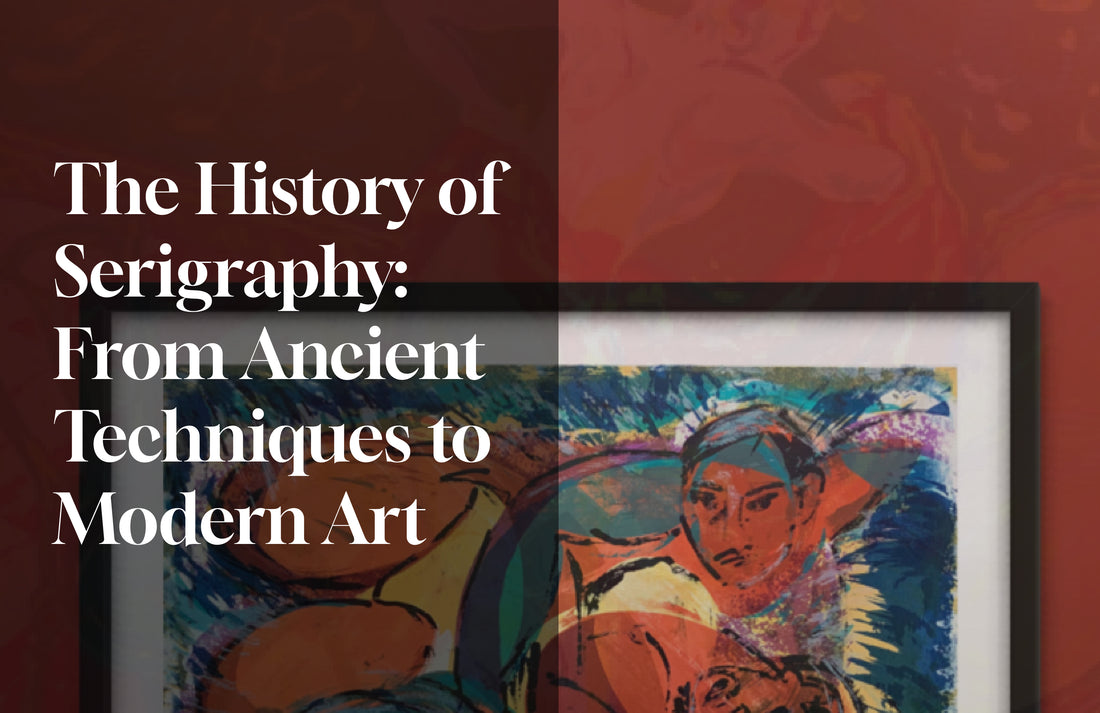
The History of Serigraphy: From Ancient Techniques to Modern Art
Share
Serigraphy, also known as silkscreen printing, is a timeless and versatile art form with a history spanning thousands of years. As a technique that has evolved across different cultures, it has played a significant role in both practical applications and artistic expression. From its ancient origins to its modern-day use in fine art, serigraphy has undergone transformations that make it an exciting medium for collectors and artists alike. This article guides you through its rich history from ancient techniques to modern art.
Ancient Beginnings
The history of serigraphy begins in ancient China, where artisans developed early forms of stencillinga techniques. Around the Song Dynasty (960–1279 AD), craftsmen used silk mesh to create intricate designs on fabrics, pottery, and other items. The method allowed for the reproduction of complex patterns on materials like textiles, which were in high demand across Asia. As serigraphy evolved, it was adopted in Japan and became more sophisticated, where a technique called katazome was developed for fabric dyeing. Katazome involved the use of stencils made from mulberry paper and was often used in the production of elaborate kimonos.
European Adoption
In the 18th century, serigraphy made its way to Europe, where it was initially employed for industrial uses like fabric printing and wallpaper production. The process was appreciated for its efficiency in mass-producing decorative patterns for textiles. Fast forward to the 1930s, artists in Europe and the United States started experimenting with serigraphy as an art form, establishing it as a key technique in graphic and commercial art.
Tip: When purchasing a limited edition serigraph, understanding the technique's historical use in design and industry can give you insight into the craftsmanship involved in each print. Serigraphy requires a deep understanding of layering and precision, a skill developed over centuries of practice.
The Pop Art Movement
The 1960s saw a revolution in the world of serigraphy with the emergence of the Pop Art movement. Artists like Andy Warhol and Roy Lichtenstein adopted the technique to produce vibrant, mass-produced artworks that challenged traditional art conventions. Warhol’s famous "Monroe" comic-inspired pieces used serigraphy to create bold, iconic works that blurred the lines between high art and commercial imagery. Warhol chose serigraphy for its ability to produce multiple copies of the same image, aligning with the Pop Art ethos of accessibility and mass production.
Tip: Serigraphs from the Pop Art era highlight the medium's power to democratise art. When you purchase a serigraph from this movement, you’re not only buying a piece of art but also investing in a cultural artifact that reflects the shifting landscape of modern art.
Contemporary Serigraphy
In the modern art world, serigraphy continues to thrive due to its versatility and ability to produce vivid, multi-layered images. Contemporary artists embrace the medium to explore a wide range of themes, from political commentary to abstract forms, pushing the boundaries of what’s possible with silkscreen printing. Artists can experiment with new materials, textures, and layering techniques that were not available in earlier periods.
Tip: Contemporary serigraphs offer you the chance to own a unique and modern piece of art that speaks to today’s issues and aesthetics. By exploring the work of current artists, you can collect serigraphs that not only fit your personal taste but also have the potential to increase in value as the artist’s reputation grows.
Conclusion
From its ancient beginnings in China and Japan to its revolutionary role in the Pop Art movement and its current status in contemporary art, serigraphy has proven to be a dynamic and enduring art form. Whether used for commercial design, fine art, or political activism, serigraphy’s ability to adapt over the centuries is a testament to its lasting influence.
By learning serigraphy's history, you can make more informed decisions when purchasing limited edition serigraphs, appreciating not only the aesthetic beauty of the works but also the deep historical and cultural significance they carry. Whether you’re drawn to the intricate layering techniques or the bold statements of contemporary pieces, your serigraph collection can be as rich and diverse as the history of the medium itself.
View Tiny Gallery's Limited Edition Serigraph Print Collection and Artists.
